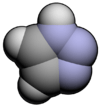1,2,3-Triazole
| |||
| Names | |||
|---|---|---|---|
| IUPAC name
1H-1,2,3-triazole | |||
| Other names
1,2,3-triazole | |||
| Identifiers | |||
| 288-36-8 | |||
| 3D model (Jmol) | Interactive image Interactive image | ||
| ChEBI | CHEBI:35566 | ||
| ChemSpider | 60839 | ||
| ECHA InfoCard | 100.128.405 | ||
| |||
| |||
| Properties | |||
| C2H3N3 | |||
| Molar mass | 69.0654 | ||
| Appearance | colorless liquid | ||
| Density | 1.192 | ||
| Melting point | 23 to 25 °C (73 to 77 °F; 296 to 298 K) | ||
| Boiling point | 203 °C (397 °F; 476 K) | ||
| very soluble | |||
| Acidity (pKa) | 1.2 | ||
| Basicity (pKb) | 9.4 | ||
| Related compounds | |||
| Related compounds |
1,2,4-triazole imidazole | ||
| Except where otherwise noted, data are given for materials in their standard state (at 25 °C [77 °F], 100 kPa). | |||
| | |||
| Infobox references | |||
1,2,3-Triazole is one of a pair of isomeric chemical compounds with molecular formula C2H3N3, called triazoles, which have a five-membered ring of two carbon atoms and three nitrogen atoms. 1,2,3-Triazole is a basic aromatic heterocycle.[1]
Substituted 1,2,3-triazoles can be produced using the azide alkyne Huisgen cycloaddition in which an azide and an alkyne undergo a 1,3-dipolar cycloaddition reaction.
It is a surprisingly stable structure compared to other organic compounds with three adjacent nitrogen atoms. However, flash vacuum pyrolysis at 500 °C leads to loss of molecular nitrogen (N2) to produce aziridine. Certain triazoles are relatively easy to cleave due to so-called ring-chain tautomerism. One manifestation is found in the Dimroth rearrangement.
1,2,3-Triazole finds use in research as a building block for more complex chemical compounds, including pharmaceutical drugs such as tazobactam.
References
- ↑ Heterocyclic chemistry T.L. Gilchrist ISBN 0-582-01421-2

